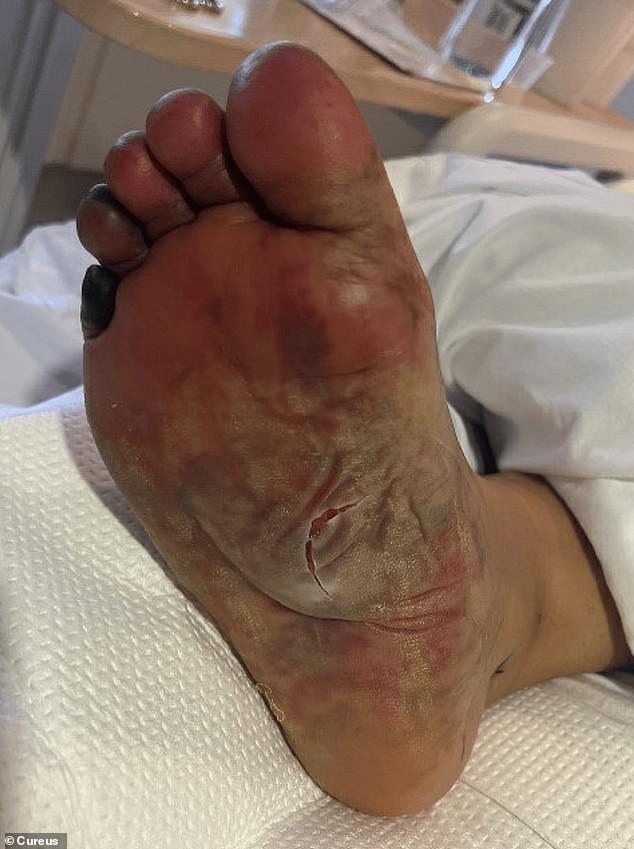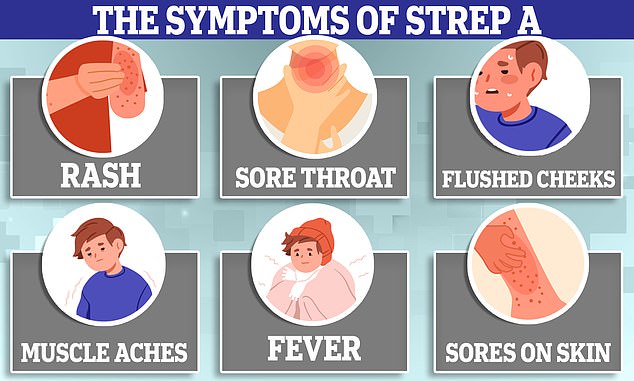Connecticut woman, 41, seriously ill with ultra-deadly flesh-eating infection sweeping Japan — should Americans worry?
Doctors in Connecticut have treated a critically ill patient with the same rare, deadly flesh-eating infection that is spreading across Japan and leaving many patients dead within 48 hours.
Doctors reported the case – a 41-year-old female patient – in March, just as Japanese authorities first warned of a rise in cases.
The woman visited her local emergency room after a week of vomiting, diarrhea and difficulty breathing.
Scans revealed fluid buildup on the left side of her lungs, as well as respiratory and kidney failure.
Doctors believe the woman’s illness was caused by Streptococcal Toxic Shock Syndrome (STSS), an extremely deadly bacterial infection that has killed 77 people in Japan so far this year, the highest number of cases in the country.
The patient’s CT scans showed fluid filling the left side of her lungs. She soon developed respiratory and renal failure

When the patient’s circulation was cut off, her toe began to turn black. Doctors think it may need to be amputated
The woman is believed to have contracted the disease behind the condition, called group A Streptococcus, by inhaling infected airborne droplets expelled through sneezing, coughing and talking.
Before seeking emergency care, a pulmonologist prescribed the woman the corticosteroid prednisone, as well as antibiotics and a drug to widen her airways.
She reported asthma, but no other chronic health problems.
However, her husband noticed that several family members had recently been diagnosed with strep throat, caused by the common bacteria group A Streptococcus.
In the hospital, the woman also had an elevated pulse and low blood pressure.
After three days in the intensive care unit, the patient stopped urinating. One of her toes also started to turn black as circulation was cut off and tissues died.
Several days later, further tests revealed STSS due to an untreated respiratory infection.
Most group A streptococcal infections cause mild illness such as strep throat.
However, when the bacteria spreads to the blood and deep tissue, patients can develop STSS, killing 30 percent of those affected.
STSS often begins with flu-like symptoms such as fever, chills, muscle aches, nausea, and vomiting.
Over time, however, blood pressure drops, heart rate and breathing speed up, and vital organs such as the lungs can begin to fail. And like the Connecticut patient, the disease attacks healthy tissues and eats away at flesh, sometimes requiring amputations.
According to the latest available CDC data, the US reported 145 STSS cases in 2021.
Cases have soared in Japan, where more than 1,000 people have been infected and 77 have died since the start of this year.

Although Strep A can cause a number of serious illnesses, it usually starts with a few typical symptoms. This includes a rash, sore throat, red cheeks, muscle aches, high fever, an ear infection and sores on the skin
It’s unclear what exactly is behind Japan’s wave, but Dr. Ken Kikuchi of Tokyo Women’s Medical University told local new outlet NHK that immunity debt due to the Covid pandemic could be partly to blame.
Immunity guilt is when the immune system becomes weaker after not being exposed to a variety of pathogens.
‘We can boost immunity if we are constantly exposed to bacteria. But that mechanism was absent during the coronavirus pandemic,” Dr Kikuchi said.
‘So more people are now susceptible to infections, and that could be a reason for the sharp rise in cases.’
However, US experts have stated that the wave is unlikely to spread to the US, and that the condition is still rare.
Dr. Andrew Steer, director of infection, immunity and global health at the Murdoch Children’s Research Institute in Australia, told the WashingtonPost: ‘We have had Streptococcal Toxic Shock Syndrome and Invasive Strep A infection for decades and decades and decades, hundreds of years in the US.’
‘It is still an uncommon infection, but the community and doctors should be aware that the number of cases is increasing.’
And while cases are rising in Japan, experts have warned that rates of flu and Covid infections are much higher. For example, more than 746,000 Covid infections have been reported this year through June 9, according to reports from more than 5,000 hospitals.
And Japan’s Ministry of Health has assured tourists that there is no need to cancel travel plans to the country. Bloomberg reports this.
STSS often results from a person with an open wound being exposed to the bacteria, as it is an easier way to infect deeper tissues.
However, in many cases the exact cause of STSS cannot be determined.
US experts have urged patients to be vigilant with open wounds, ensuring they are cleaned and dressed effectively.
The Connecticut patient underwent a course of antibiotics and inpatient rehabilitation, although doctors noted she may need to have one toe amputated.
The case report was published in the journal Cureus.
